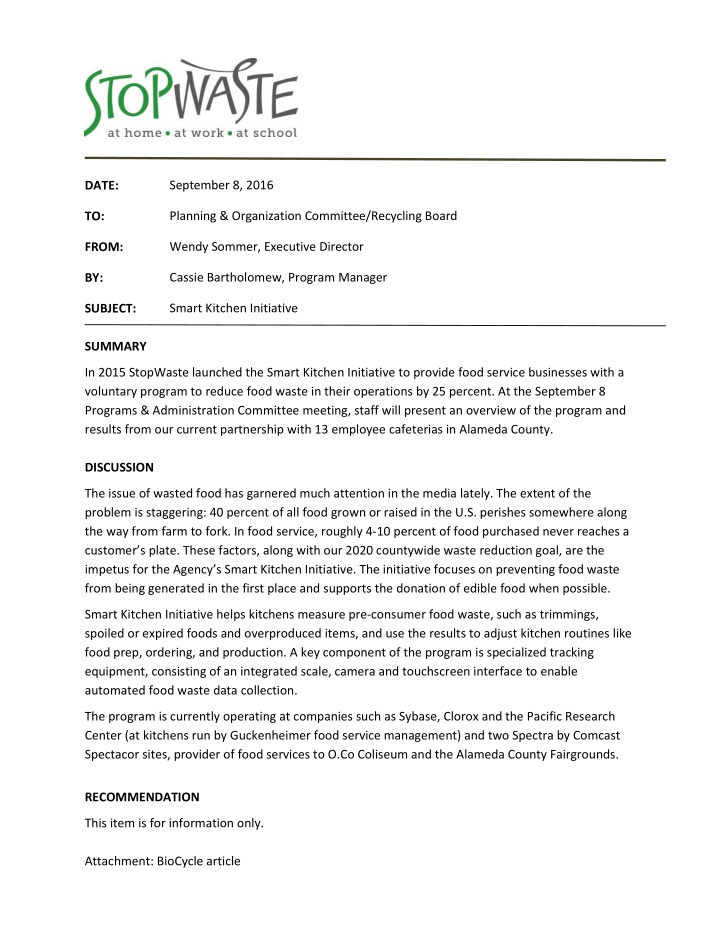



DATE: September 8, 2016 TO: Planning & Organization Committee/Recycling Board FROM: Wendy Sommer, Executive Director BY: Cassie Bartholomew, Program Manager SUBJECT: S mart Kitchen Initiative SUMMARY In 2015 StopWaste launched the Smart Kitchen Initiative to provide food service businesses with a voluntary program to reduce food waste in their operations by 25 percent. At the September 8 Programs & Administration Committee meeting, staff will present an overview of the program and results from our current partnership with 13 employee cafeterias in Alameda County. DISCUSSION The issue of wasted food has garnered much attention in the media lately. The extent of the problem is staggering: 40 percent of all food grown or raised in the U.S. perishes somewhere along the way from farm to fork. In food service, roughly 4-10 percent of food purchased never reaches a customer’s plate. These factors, along with our 2020 countywide waste reduction goal, are the impetus for the Agency’s Smart Kitchen Initiative. The initiative focuses on preventing food waste from being generated in the first place and supports the donation of edible food when possible. Smart Kitchen Initiative helps kitchens measure pre-consumer food waste, such as trimmings, spoiled or expired foods and overproduced items, and use the results to adjust kitchen routines like food prep, ordering, and production. A key component of the program is specialized tracking equipment, consisting of an integrated scale, camera and touchscreen interface to enable automated food waste data collection. The program is currently operating at companies such as Sybase, Clorox and the Pacific Research Center (at kitchens run by Guckenheimer food service management) and two Spectra by Comcast Spectacor sites, provider of food services to O.Co Coliseum and the Alameda County Fairgrounds. RECOMMENDATION This item is for information only. Attachment: BioCycle article
This page intentionally left blank
Smart Kitchen Initiative Reduces Wasted Food Cassie Bartholomew, Program Manager September 8, 2016
Food Waste Recovery Hierarchy Preferred Not Preferred
Lots of resources go into the production of food before it reaches a plate
Who? Food service providers, caterers and commercial kitchens with an annual food spend of $300k -750k or more . •Cultural & Sports Venues •Educational Institutions •Health Care Facilities •Hotels & Lodging •Corporate Cafeterias Sybase, Dublin, CA
Why Food Service Operators? • High potential for savings 4-10% of food purchased by food service operators thrown out before it reaches a plate. • Large number of operators in the county Over 5,200 food service operators • Operation size justifies tracker expense First year paid by StopWaste, thereafter site would cover portion of leasing cost.
Two Types of Food Waste Pre-Consumer: Post-Consumer: “Kitchen Waste” “Plate Waste”
Sources of Pre-Consumer Food Waste Trimmings Expiration Spoilage Overproduction
Kitchen Servery Tracking Systems Garbage / Compost/ Disposal / Donation/ Potential Donation
The Offer: • Free automated LeanPath food waste monitoring system and software • License for one year. • Hands-on coaching, staff training & ongoing support • Customized weekly/monthly reports and action items • $4,500 to $10,000 value
Memorandum of Understanding (MOU) Food Service Operator Commitments: • Install, be trained in and use tracking equipment • Assign Champion(s) and make staff time available • Set monthly waste reduction goals • Attend quarterly review calls/meetings
Current Program Participants: Spectra – Event Venue Management O.Co Coliseum (Launched Nov 2015) Alameda County Fairgrounds (Launched July 2015)
Current Program Participants: Guckenheimer - Onsite Corporate Dining 13 employee cafeterias (Launched Dec 2015) Annual food spend of $150K - $1 Mil
Results July 2015 - September 2016 • 13,238 transactions • 87,601 lbs. recorded • $55,078 estimated value • 10,997 lbs. (16%) marked as “edible”
Tracking Results in Action: Salad Bar The Problem: Highly visible salad bar has to look plentiful at all times, leading to overproduction. Solution: More shallow pans provide the visual with less waste.
Tracking Results in Action: Soup of the Day The Problem: Recurring overproduction of soup Solution: - Offer soup as an add-on (free or discounted) to salad and sandwich entrees - Make Friday’s soup “Chef’s Choice” to incorporate leftovers from earlier in the week - Offer quart-sized soup containers in the grab-n-go station for customers to purchase and take home for dinner
Average Average Reduction vs. Reduction vs. Guckenheimer -Site Names Spectra -Site Names Baseline (by Baseline (by weight) weight) Pacific Research Center – Gateway Café O.Co Coliseum –Main Kitchen (Football) 77% 62% O.Co Coliseum –Main Kitchen (Baseball) Wind River 48% 58% O.Co Coliseum –Bar & Grille (Football) Sybase/SAP 62% 47% O.Co Coliseum –Bar & Grille (Baseball) State Comp Insurance –Patio Café 42% 73% Alameda County Fairgrounds Ross Dress For Less – Ross Café 40% 65% Mentor Graphics – Nourish Café 37% Clorox – Café Hive 33% Byte 33% LAM Livermore Café 31% Nearly all of the Guckenheimer Thrive Café 26% sites reached or surpassed the Safeway Canyon Way Café 24% 25% reduction goal within 6 LAM Research n/a months of the program. Stryker – Neuro Café n/a
Success Story: Food Donations at O.Co Coliseum • Tracking brought awareness to overproduction • Chef now coordinates directly with food rescue organization • 4,251 lbs. of produce, dairy and prepared food donated as of August
What’s Next FY 16-17: • Recruiting new SKI sites • K-12 School Food Share/Food Donation • Food Recovery Gap Analysis • Consumer Media and Outreach Campaign
Recommend
More recommend